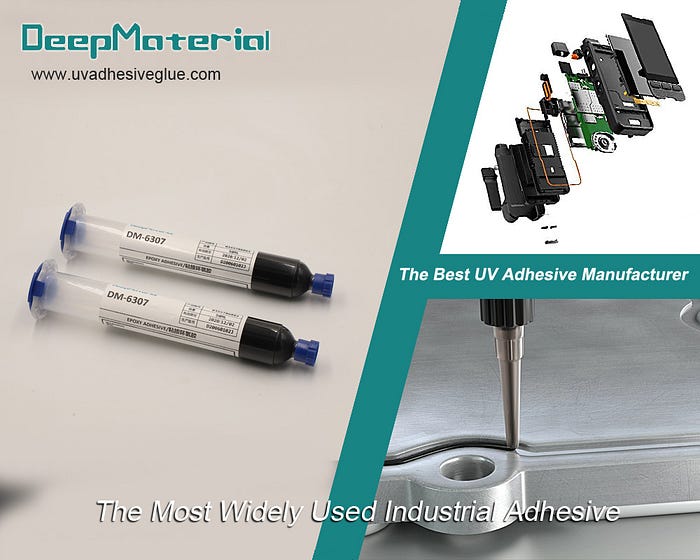UV (ultraviolet) glue, also known as UV cure adhesive for metal, is a type of adhesive that cures or hardens when exposed to ultraviolet light. And it’s used for assembly bonding or device protection, has excellent bonding ability for most substrates, including glass, a variety of plastics and most metals, especially for occasions requiring large gap filling capacity and flexible joint. The flexibility of the product can effectively improve the load bearing capacity of the bonding surface, improve the damping characteristics, and have excellent solvent resistance.It has a wide range of applications across various industries, and it offers several advantages over traditional adhesives, such as rapid curing times, strong bonding capabilities, and the ability to bond a wide range of materials, including metals.

Here are some applications of UV cure adhesive for metal:
Industrial Manufacturing: UV-curing adhesive is widely employed in industrial manufacturing for the bonding and assembly of metal components. Whether it’s automotive parts, household appliances, machinery, or other industrial products, UV-curing adhesive is utilized to enhance the connections between metal parts.
Medical Devices: In the medical field, UV glue can be employed to bond metal parts of medical devices, such as bonding metal needles to plastic hubs or attaching metal components in surgical instruments. Its rapid curing time is advantageous for assembling medical equipment that needs to be quickly sterilized and put into use.
Optical Devices: UV glue is used in the assembly of optical devices like cameras, lenses, and microscopes. It can bond metal parts without affecting the precision and clarity of the optical components.
Aerospace and Automotive Industries: UV cure adhesive for metal parts in the manufacturing of automotive and aerospace components, ranging from interior parts to structural elements. It can help with lightweight designs and reduce the need for heat-sensitive adhesives in critical areas.
Camera Manufacturing: In camera production, UV-curing adhesive can be used to fix lenses, metal casings, and other metal components. Its quick curing properties expedite the camera assembly process.
Speaker Assembly: UV-curing adhesive can be applied in speaker assembly, including fixing metal speaker driver units onto casings or metal frames.
Display Manufacturing: In the manufacturing of Liquid Crystal Displays (LCD) and Organic Light-Emitting Diode Displays (OLED), UV-curing adhesive is used to attach metal brackets, frames, and other metal components. This ensures both structural integrity and an aesthetically pleasing appearance of displays.
Electronics Assembly: in the electronics manufacturing, UV glue can be used to bond metal components in electronic devices, such as securing wires, connectors, and small metal parts on circuit boards.UV-curing adhesive can also be used to affix electronic components such as connectors and sensors onto metal substrates, ensuring their stable positioning and reliable connections. For microelectronic devices like miniature cameras, tiny speakers, and sensors, UV cure adhesive for metal bonding within confined spaces.It can secure delicate electronic components onto metal substrates without subjecting them to high temperatures that could potentially damage the components. UV glue can be used in the assembly of consumer electronic devices like smartphones and tablets. It provides strong bonding for metal frames and glass panels while maintaining a clean appearance.
Internal Cable Fastening: Within devices, UV-curing adhesive can secure metal cables, wires, and harnesses, maintaining their organized arrangement and preventing loosening.
Repair and Maintenance: UV-curing adhesive is also commonly used for repairing and maintaining electronic devices. For instance, during phone screen repairs, it can be employed to reattach metal brackets and display glass.
Jewelry and Accessories: UV glue is it is commonly used in the jewelry industry for assembling metal components, such as setting gemstones onto metal settings or bonding metal clasps to leather or fabric. Artists and craftsmen use UV glue to create metal sculptures or jewelry pieces. It can bond metal components together without the need for visible fasteners, creating a seamless and aesthetically pleasing finish.
Watchmaking: UV glue is used in the watchmaking industry to bond metal components, such as attaching watch crystals to metal watch cases.
Model Making: Model builders and hobbyists use UV glue to bond metal parts in miniature models, replicas, and dioramas.
Marine and Nautical Applications: UV glue can be used to bond metal components in marine and nautical equipment, such as attaching metal fittings to boats or yachts.
Custom Metal Fabrication: UV glue can be employed in custom metal fabrication for creating artistic or functional metal structures.
Display and Signage: UV glue can be used to bond metal letters, logos, and decorative elements onto signs and displays.
The application of UV cure adhesive for metal is indeed highly diverse, spanning various fields and industries, owing to its rapid curing, strong bonding capabilities, and compatibility with a wide range of metal materials. Its ability to bond quickly and reliably makes it a crucial tool in modern manufacturing and assembly processes.

Best UV Glue For Metal
It’s important to note that while UV glue offers several advantages, such as rapid curing and strong bonds, when using UV glue on metals, it’s important to consider the compatibility of the adhesive with the specific types of metal surfaces you’re working with. Some metals may require surface preparation, such as cleaning, sanding, or priming, to ensure optimal adhesion. Additionally, the curing process involves exposing the adhesive to UV light of the appropriate wavelength and intensity for the recommended duration.
As with any adhesive application, it’s recommended to follow the manufacturer’s guidelines and conduct tests to ensure that the UV glue meets the desired performance criteria for your specific application on metal surfaces.
